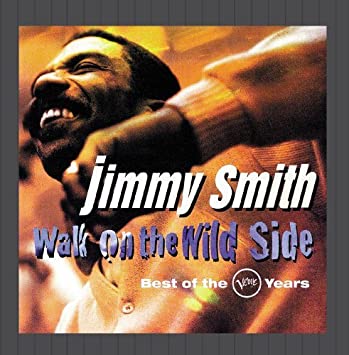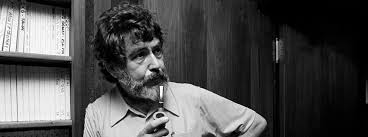-
Posts
13,205 -
Joined
-
Last visited
-
Donations
0.00 USD
Content Type
Profiles
Forums
Events
Blogs
Everything posted by Larry Kart
-

Notable young sidemen in big bands in the 70s-80's
Larry Kart replied to Rooster_Ties's topic in Miscellaneous Music
Thad and Mel tenor saxophonist Gregory Herbert (non-white guy -- fine player, sadly deceased way too young). Regarding Chuck's long ago question, given the nature stylistically of many (most?) regulariy working big bands of that period, how many young black players of the time would have wanted to play in those bands? For various reasons they largely played for white audiences and played the sort of material those audiences expected and wanted to hear. Steve Coleman (above) did want to play with Thad and Mel and did so, but that band was sui generis. -
Arranged -- quite beautifully IMO -- by sometime visitor to Organissimo IIRC trombonist Paul McKee. Trumpet soloist is Clay Jenkins. BTW Jim Sangrey, Pete Galio is on this band and takes several solos.
-
I believe that Duke was a prime instigator of this side of Koenig's interests. A side/subsidiary Koenig label in that vein was Society for Forgotten Music. Again an offspring in part of Duke's interests; I believe, it focused on semi-obscure 19th and 18th Century ,music. I have a few SFM albums, and they're quite good. Performers are top-level LA studio musicians, like violinist Israel Baker. Society for Forgotten Music Label Discography 1000 mono /2000 stereo 12 inch series: SFM 1001mono, 7006 stereo – Mendelssohn: Quartet In E flat and Glinka:Quartet in F - Westwood Quartet [5/58] Released in stereo on Stereo Records 7006. SFM 1002 mono – Jan Ladislaw Dussek: Piano Music – Hermanns & Stoneridge [6/58] No stereo release. SFM 1003 mono, 7014 stereo - Works of Chausson: Quartet in A Op. 30 (piano) - Andre Previn and the Roth Quartet [1958] Released in stereo on Stereo Records 7014. SFM 1004 mono, 7023 stereo - Works of Guillaume Lekeu: Trio in C – Ryshna, Baker And Kaparoff [1958] Release in stereo on Stereo Records 7023. SFM 1005 mono, 2005 stereo – Michael Haydn Quintets in C & G for Strings – Roth Quartet, Halleux [1959] SFM 1006 mono, 2006 stereo – Viotti: Quartets in B flat and G for Strings – Baker Quartet [1959] SFM 1007 mono, 2007 stereo – Mily Balakirev Sonata: Berceuse Nocturne; Valse – Ryshna SFM 1008 mono, 2008 stereo – Lekeu Piano Quartet; Cello Sonata, Trois Poemes Van den Burg, Duke, McCraken– Ryshna, Baker Quartet SFM 1009 mono, 2009 stereo – Wilhelm Friedemann Bach Polonaises (12) Sonatas;Suite; Fugue; March – Hermanns (Piano) SFM 1010 mono, 2010 stereo – Mozart: Andantino in B flat for Cello and Piano Sonata in E for Cello and Piano, Bonifazio Sonata in C for Cello and Piano – Kaufman, Neikrup
-
They were a couple at one point, and Harte later on volunteered much detail about Lady Day's sexual tastes.
-
"And the sex scenes are EMBARRASSING." Was Roy Harte a consultant?
-
Happy to be your friend, TTK, though I already have a good many. Bonnie, however, though we've never met, would be a friend and a half. She did send me a nice postcard once after I wrote a review that praised a friend of hers, singer-pianist Audrey Morris.
-
My fondue party will have one guest, Bonnie Herman.
-
You have a fertile (too fertile?) imagination.
-
"Ennui" and the Singers Unlimited? "Ennui" and the Singers Unlimited? I don't know what you're talking about. I think of their music in terms of joyful sophistication, harmonic sophistication in particular.
-
At a library sale over the weekend I was delighted to find two MPS double CDs (40 or more tracks each) and one single CD (20 tracks), in top drawer MPS sound but with no annotation. $3 total. Won't replace all my old SU LPs, but the upgrade in sound is considerable. They're labeled CD 3/4,CD 5/6, and CD 7. Don't see other volumes on Amazon. Oops -- these must have come from the "Magic Voices" box set, which goes for $129.
-
My favorite Fuller live performance was in Chicago at the North Park Hotel circa 1971 with the Joe Henderson band that appeared on half of "In Pursuit of Blackness" (with Pete Yellen, George Cables, Stanley Clarke, and Lenny White). Fuller was on fire, roughing up his sound in a speechlike manner like a hardbop Dickie Wells. Helluva rhythm section that was, not too long before we pretty much lost Clarke for good.
-
Thanks. Clarinets would have been my guess.
-
Two-CD compilation of Smith's Verve material -- big band and small group. Big band arrangements, mostly by Oliver Nelson, are excellent, more varied than one might think (check out the mysterioso "St. James Infirmary" -- does Nelson really get those upper-register shrieks from a band (on this track) with no brass, only reeds and rhythm?) and played with much zest by all. Grady Tate in top form does most of the drum work, but don't miss Ed Shaughnessy on the title track. Some fine Burrell and a very nice outing from Eric Gale.
-

What Classical Music Are You Listening To?
Larry Kart replied to StarThrower's topic in Classical Discussion
Zacharias I've got his concerti box set. -
Someone else who gets the beginning and indeed the whole symphony just right -- Bruno Walter in the work's very first recording back in 1945, with the New York Philharmonic. I'd forgotten I had that performance on CD, with some works by Richard Strauss.
-
"...maybe it could be a combination of negotiating the 6/4 / 4/4 signatures that begins the work with orchestral balance." I'll bet that's it, and I'd add that there's something in those opening measures that tends to make a conductor and an orchestra want to more or less "hurtle" ahead, and then, if they do, it sounds like they almost immediately run into figures/phrases that need to be reined in, under fairly tight control rhythmically, which is where Hanson's recording is so good. The initial forward momentum is all there, and the reining in is unanimous -- no sense, as in some other performances, that the band is teetering on its toes and about to collapse into the following measures.
-
Thanks, but it doesn't zero in on what seems to be the musical-interpretive problem at the very beginning of movement 1 in most recordings, Hanson's and Measham's excepted.
-
-
Can someone tell me what it is about the opening of this work -- it's primarily a rhythmic issue I think, but also perhaps a matter of scoring -- that makes it so hard to get right? The first recording from 1973, which I heard way back when, cond. by David Measham with the LSO (Unicorn) comes pretty close, but the others I know (cond. by David Zinman, Leonard Slatkin, Marin Alsop) are an unholy mess. And then there's one on YouTube from the '50s that's just perfect, Howard Hanson with the Eastman-Rochester orchestra (Mercury). But aside from being able to hear the differences, for the life of me I can't tell just what the musical-interpretive problem there is, other than that Measham comes close to solving it, Hanson does so superbly, and the other three baton wielders (all of them supposedly Barber specialists) are completely clueless. (Disregard second clip below, see next post for correct one).
-
Red's slow-motion version of "Mr. Wonderful" (on the double LP "Undiscovered Masters"), with Doug Watkins and Specs Wright, is a hallucinatory masterpiece.
-

Hasaan Ibn Ali – Metaphysics: The Lost Atlantic Album
Larry Kart replied to king ubu's topic in New Releases
About the distressingly murky sound, I find that things can be improved a fair bit if one increases the volume level considerably and also boosts treble some. The trick is to get Hasaan's piano to sound as much like a piano as possible; then things begin to fall into place to some degree.- 103 replies
-
- hasaan
- hasaan ibn ali
-
(and 5 more)
Tagged with:
-

What Classical Music Are You Listening To?
Larry Kart replied to StarThrower's topic in Classical Discussion
Think I have that recording: I'll give it a listen. -
We both noticed that -- used to drive me crazy. Also, there was the way he recycled chunks of material from former notes on the same artist. In the old old days, he was pretty reliable Downbeat review, but when Martin Williams arrived, a whole new world opened up to me. Also, I it seemed like some, maybe many, of Nat's opinons were borrowed from Martin.
-
-
Sorry, I was trying to be wise guy. Myself, I wouldn't pay for anything by Oregon.
_forumlogo.png.a607ef20a6e0c299ab2aa6443aa1f32e.png)


